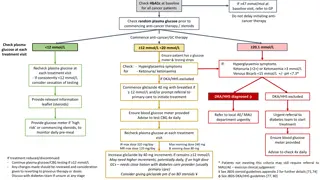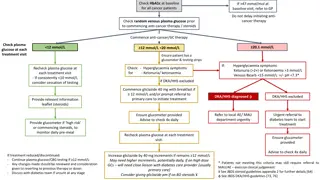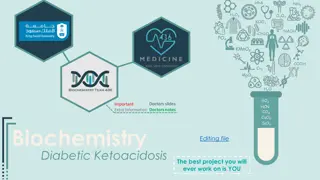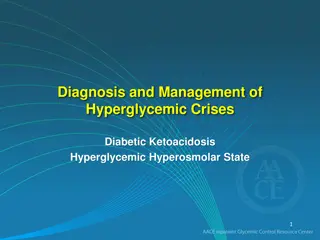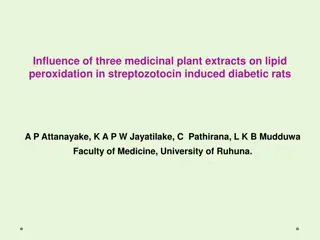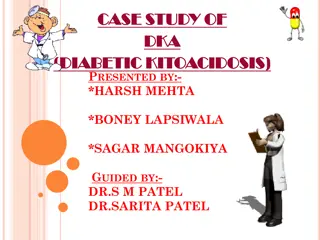Acute Diabetic Ketoacidosis in a 19-Year-Old Male
Acute presentation of a 19-year-old man with diabetic ketoacidosis (DKA) characterized by hyperglycemia, anion-gap acidosis, and ketosis. Clinical findings include dehydration, hyponatremia, hypotension, altered consciousness, and abdominal pain. Immediate management involves ABCs, fluid resuscitation, insulin therapy initiation, and search for precipitating factors. Prompt recognition and comprehensive care are essential for a successful outcome.
Download Presentation

Please find below an Image/Link to download the presentation.
The content on the website is provided AS IS for your information and personal use only. It may not be sold, licensed, or shared on other websites without obtaining consent from the author.If you encounter any issues during the download, it is possible that the publisher has removed the file from their server.
You are allowed to download the files provided on this website for personal or commercial use, subject to the condition that they are used lawfully. All files are the property of their respective owners.
The content on the website is provided AS IS for your information and personal use only. It may not be sold, licensed, or shared on other websites without obtaining consent from the author.
E N D
Presentation Transcript
A 19-year-old man is brought to the emergency department (ED) with diffuse abdominal pain, vomiting, and altered level of consciousness. The patient s symptoms began several days ago, when he complained of the flu. His symptoms at that time included profound fatigue, nausea, mild abdominal discomfort and some urinary frequency. Today he was found in bed moaning but otherwise unresponsive. His past medical history is unremarkable, and he is currently taking no medications. On physical examination, the patient appears pale and ill. His temperature is 36.0 C (96.8 F), pulse rate is 140 beats per minute, blood pressure is 82/40 mm Hg, and the respiratory rate is 40 breaths per minute. His head and neck examination shows dry mucous membranes and sunken eyes; there is an unusual odor to his breath. The lungs are clear bilaterally with increased rate and depth of respiration. The cardiac examination reveals tachycardia, no murmurs, rubs, or gallops. The abdomen is diffusely tender to palpation, with hypoactive bowel sounds and involuntary guarding. The rectal examination is normal. Skin is cool and dry with decreased turgor. On neurologic examination, the patient moans and localizes pain but does not speak coherently. Laboratory studies: the leukocyte count is 16,000 cells/uL, and the hemoglobin and hematocrit levels are normal. Electrolytes reveal a sodium of 124 mEq/L, potassium 3.4 mEq/L, chloride 98 mEq/L, and bicarbonate 6 mEq/L. BUN and creatinine are mildly elevated. The serum glucose is 740 mg/dL (41.1 mmol/L). The serum amylase, bilirubin, AST, ALT, and alkaline phosphatase are within normal limits. A 12-lead ECG shows sinus tachycardia. His CXR is normal.
Summary: This is a 19-year-old man with acute diabetic ketoacidosis. The patient has new-onset diabetes mellitus. The constellation of severe hyperglycemia, aniongap acidosis, and ketosis (manifested by the breath odor) is diagnostic. The other findings of dehydration, hyponatremia, hypotension, altered level of consciousness, and diffuse abdominal pain, are typical of a particularly severe episode of diabetic ketoacidosis. Most likely diagnosis: Diabetic ketoacidosis Next step: Management of the ABCs, including fluid resuscitation, the initiation of insulin therapy, and a careful search for any precipitating or concomitant illness.
Considerations This patients clinical presentation is typical for diabetic ketoacidosis. Morbidity may result from either underlying precipitating conditions, or from delayed or inadequate treatment. Prompt recognition, effective resuscitation, and diligent attention to fluid, electrolyte, and insulin replacement are essential. (Table 5 1 lists typical laboratory values in DKA). A comprehensive and thoughtful search for associated illnesses, along with frequent reassessment of the patient, will lead to the best outcome.
CLINICAL APPROACH Diabetic ketoacidosis is a metabolic emergency. A delay in treatment leads to increased morbidity and mortality. In up to one-quarter of patients, DKA is the initial presentation of type I diabetes, so lack of a diabetic history cannot exclude the diagnosis. Most cases occur in patients with type I diabetes, though some patients with type II diabetes may develop DKA during severe physiologic stress.
and insulin deficiency can lead to potassium shifts into the extracellular space, so patients may have significant serum hyperkalemia at presentation, even with massive total body deficits of potassium. Nausea and vomiting can be severe and further cloud the clinical picture with variable superimposed acid-base and electrolyte disturbances.
Diagnosis is based on the triad of hyperglycemia, ketosis, and metabolic acidosis
Patients in DKA can have massive fluid deficits, sometimes as much as 5 to 10 L. Shock is fairly common, and must be promptly treated with crystalloid infusion to prevent further organ damage. Adults with clinical shock should receive an initial 2-L bolus of normal saline with frequent reassessment. In children, shock is treated with boluses of 20 mL/kg of normal saline. Although overaggressive hydration can present substantial complications later in the course of treatment, this concern takes a back seat to the reversal of shock. Untreated shock promotes multiple-organ dysfunction and contributes further to the severe acidosis seen in DKA.
The combination of rehydration and insulin will commonly lower the serum glucose much faster than ketones are cleared. Regardless, insulin infusion should continue until the anion gap has returned to normal. Dextrose should be added to the IV infusion when the serum glucose falls to 200 to 300 mg/dL (11.1-16.7 mmol/L) to prevent hypoglycemia, a common complication of treatment. An insulin dose of 0.1 U/kg/h (5-10 U/h in the adult) is adequate for almost all clinical situations. This is sufficient to achieve maximum physiologic effect. Higher doses are no more effective, but do cause a higher rate of hypoglycemia. An initial bolus of insulin, equal to 1-hour infusion, is commonly given but has not been shown to hasten recovery or provide any other benefit. Insulin boluses are not recommended in pediatric patients. Insulin does bind readily to common medical plastics, so IV tubing should be thoroughly flushed with the drip solution at the start of therapy.
The combination of rehydration and insulin will commonly lower the serum glucose much faster than ketones are cleared. Regardless, insulin infusion should continue until the anion gap has returned to normal. Dextrose should be added to the IV infusion when the serum glucose falls to 200 to 300 mg/dL (11.1-16.7 mmol/L) to prevent hypoglycemia, a common complication of treatment. An insulin dose of 0.1 U/kg/h (5-10 U/h in the adult) is adequate for almost all clinical situations. This is sufficient to achieve maximum physiologic effect. Higher doses are no more effective, but do cause a higher rate of hypoglycemia. An initial bolus of insulin, equal to 1-hour infusion, is commonly given but has not been shown to hasten recovery or provide any other benefit. Insulin boluses are not recommended in pediatric patients. Insulin does bind readily to common medical plastics, so IV tubing should be thoroughly flushed with the drip solution at the start of therapy.
Patients in DKA generally have massive total body deficits of water, sodium, potassium, magnesium, phosphate, and other electrolytes. Specific laboratory values may vary widely depending on the patient s intake, gastrointestinal and other losses, medications, and comorbid illnesses. It is not usually necessary to calculate exact sodium and water deficits and replacements, except in cases of severe renal failure. Simply reverse shock with normal saline, and then continue an infusion of halfnormal saline at two to three times maintenance. Remember that glucose should be added before the serum glucose falls to the normal range, usually when the glucose level reaches 250 mg/dL.
Potassium deficits are usually quite large, yet the serum potassium at presentation may be low, normal, or even high. If the potassium is elevated initially, look for and treat any hyperkalemic changes on the ECG. Give fluids without potassium until the serum K reaches the normal range, and then add potassium to the IV infusion. If the initial serum K is normal or low, potassium replacement can be started immediately. Magnesium supplementation may be necessary to help the patient retain potassium. Phosphate replacement has not been shown to improve clinical outcomes, but extremely low phosphate levels (<1.0 mg/dL) are known to cause muscle weakness and possibly rhabdomyolysis. For such patients, some of the potassium can be given in the form of potassium phosphate.
Because metabolic acidosis is such a prominent feature in DKA, some clinicians have administered substantial doses of sodium bicarbonate. Many studies have failed to demonstrate any improvement from this treatment even at surprisingly low serum pH values, but even skeptical physicians sometimes encounter a patient who is so acidotic that they feel compelled to give bicarbonate. There are multiple theoretical and observed complications from bicarbonate, including hypernatremia, hypokalemia, paradoxical CSF acidosis, and residual systemic alkalosis. Of course, in the case of hyperkalemia, bicarbonate might be lifesaving and should not be withheld
Cerebral edema is a rare but devastating complication of DKA, seen most often and most severely in children. It almost always occurs during treatment, and is a leading cause of morbidity and mortality in pediatric DKA. It has been ascribed to the development of cryptogenic osmoles in the CNS to counter dehydration, which then draw water intracellularly during treatment, but this remains unproven. It has been variously associated with overhydration and vigorous insulin therapy, leading many pediatric centers to use extremely conservative, slow and low-dose treatment protocols for DKA. However, at least one large well-controlled study showed that the only reliable predictor of cerebral edema was the severity of metabolic derangements at presentation. Concern for cerebral edema should never be used as an excuse for the undertreatment of clinical shock. Once shock is reversed, pediatric DKA patients should be managed in consultation with an experienced pediatric endocrinologist or intensivist.







